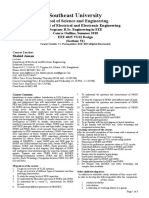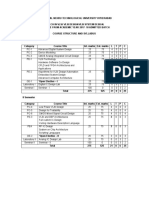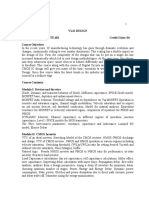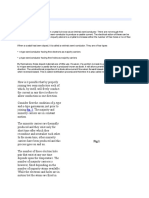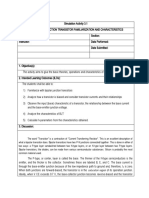0 ratings0% found this document useful (0 votes)
143 viewsCourse Information Sheet
This document provides information on the VLSI Design course offered as part of the B.Tech ECE degree program. The course is a core course offered in the second semester for 4 credits. It has 4+1 hours of contact time per week. The syllabus is divided into 8 units covering topics such as IC technology, MOS transistor properties, VLSI circuit design processes, digital design using HDL, and VHDL modeling. The course objectives are to understand MOS and Bi-CMOS circuit properties, VLSI design approaches, and use of VHDL for digital circuits. Assessment methods include assignments, tests, examinations, and student feedback.
Uploaded by
KameshSontiCopyright
© © All Rights Reserved
Available Formats
Download as DOCX, PDF, TXT or read online on Scribd
0 ratings0% found this document useful (0 votes)
143 viewsCourse Information Sheet
This document provides information on the VLSI Design course offered as part of the B.Tech ECE degree program. The course is a core course offered in the second semester for 4 credits. It has 4+1 hours of contact time per week. The syllabus is divided into 8 units covering topics such as IC technology, MOS transistor properties, VLSI circuit design processes, digital design using HDL, and VHDL modeling. The course objectives are to understand MOS and Bi-CMOS circuit properties, VLSI design approaches, and use of VHDL for digital circuits. Assessment methods include assignments, tests, examinations, and student feedback.
Uploaded by
KameshSontiCopyright
© © All Rights Reserved
Available Formats
Download as DOCX, PDF, TXT or read online on Scribd
You are on page 1/ 3
COURSE INFORMATION SHEET
PROGRAMME: B.Tech in ECE DEGREE: BTECH
COURSE: VLSI Design SEMESTER: II CREDITS: 4
COURSE CODE:R32045
REGULATION:R10
COURSE TYPE: CORE
COURSE AREA/DOMAIN: ECE / VLSI CONTACT HOURS: 4+1 (Tutorial) hours/Week.
CORRESPONDING LAB COURSE CODE (IF
ANY):R32048
LAB COURSE NAME: Electronic Computer Aided
design Laboratory
SYLLABUS:
UNIT DETAILS HOURS
I
INTRODUCTION: introduction to IC Technology, the IC Era, MOS and related VLSI
technology .Basic MOS transistors, enhancement and depletion modes of transistor action, IC
production process, MOS and CMOS fabrication process BICMOS technology, Comparison
between CMOS and Bipolar technologies.
8
II
BASIC ELECTRICAL PROPERTIES OF MOS AND BICMOS CIRCUITS: I
ds
versus
V
ds
Relationships, aspects of MOS transistor threshold voltage, MOS trans conductance and
output conductance , MOS transistor figure of merit, the pass transistor ,then MOS inverter
,determination of pull up to pull- down ratio for nMOS inverter driven by another nMOS
inverter and for an nMOS inverter driven through one or more pass transistors ,alternative
forms of pull up, the CMOS inverter ,MOS transistor circuit model ,Bi-CMOS inverter ,latch
up in CMOS circuits and BiCMOS latch up susceptibility
9
III
MOS AND BICMOS CIRCUIT DESIGN PROCESSES:MOS layer ,stick diagrams
,design rules and layout, general observations on the design rules .2m double metal double
poly CMOS/BICMOS rules ,1.2 m double metal ,double poly CMOS rules ,layout diagrams
if NAND and NOR gates and CMOS inverter ,Symbolic diagrams Translation on mask
form.
8
IV
BASIC CIRCUIT CONCEPTS: Sheet resistance ,sheet resistance concepts applied to MOS
transistors and invertors ,area capacitance of layer ,standard unit of capacitance some area
capacitance calculations ,the delay unit ,inverter delays ,driving large capacitive loads
,propagation delays, wining capacitances ,fan in and fan out characteristics, Choice of layers,
transistor switches, realization of gates using nMOS, pMOS and CMOS technologies.
9
V
SCALING OF MOS CIRCUITS: Scaling models and scaling factors, scaling factors for
device parameters, limitations of scaling, limits due to sub threshold currents .limits on logic
levels and supply voltage due to noise ,limits due to current density ,some architectural issues
,introduction to switch logic and gate logic.
7
VI
SEMICONDUCTOR INTEGRATED CIRCUITS DESIGN: Introduction to
programmable logic devices (PLDs),programmable logic arrays (PLA) ,programmable array
logic(PAL) ,implementation approaches in VLSI design full custom design ,semi custom
design gate arrays ,standard cells ,complex programmable logic devices (CPLDs),field
programmable gate arrays (FPGAs),Design issues .
8
VII
DIGITAL DESIGN USING HDL: Digital system design process, VLSI circuit design
process ,Hardware simulation ,Hardware Synthesis History of VHDL,VHDL requirements
,levels of abstraction, elements of VHDL ,packages ,libraries and bindings ,objects and
classes ,variables assignments ,sequential statements ,usage of subprograms ,comparison of
VHDL and verilog HDL
8
VIII
VHDL MODELLING: Simulation ,logic Synthesis ,inside a logic synthesizer ,constraints
,technology libraries ,VHDL and logic synthesis ,functional gate level verification ,place and
route ,post layout timing simulation ,static timing ,major net list formats for design
representation ,VHDL synthesis programming approach .
7
TOTAL HOURS 64
TEXT/REFERENCE BOOKS:
T/R BOOK TITLE/AUTHORS/PUBLICATION
T
Essential of VLSI Circuits and systems Kamran Eshraghian,Douglas and A.Pucknell and Sholeh
Eshraghian ,prentice-Hall of india private limited .2005 edition .
T
Vlsi design A Shanthi and A.Kavita, new age international private limited ,2006 first edition
T
VLSI design K.Lal kishore and V.S.V.Prabhakar, I.K.international publishing house private
limited, 2009 first edition
R VLSI Design By Debaprasad Das, Oxford university press, 2010
R VLSI Design By A.Albert Raj & T.Latha, PHI Learing private limited 2010
R
Principles of VLSI and CMOS integrated circuits by richa jain & Amrita Rai. S,Chand, & company
limited, First Edition, 2012
COURSE PRE-REQUISITES:
C.CODE COURSE NAME DESCRIPTION YEAR/SEM
R21026 Electronic devices & Circuits MOSFET,BJT II/I
R22029 Switching theory & Logic
Design
Digital Circuits II/II
R31042 Digital IC Applications Logic families III/I
COURSE OBJECTIVES:
1 To understand Electrical Properties of MOS and Bi-CMOS Circuits.
2 To discuss about various Design Approaches in VLSI design.
3 To understand the design and analyze digital circuits, understand transistor operations, circuit
families, area-power-performance analysis, layout design techniques.
4
To describe Electronic Systems (digital hardware) at various levels of abstractions using VHDL.
COURSE OUTCOMES:
SNO DESCRIPTION PO MAPPING
1 Understand about Electrical Properties of MOS and Bi-CMOS Circuits. A,C,E,F,G,I,K
2 Understand about the Design Issues. A,B,C,D,E,F,G,H,I,J,K
3 Able to write the HDL code for different digital circuits in different
models.
A,B,C,D,E,F,G,H,I,J,K
GAPS IN THE SYLLABUS - TO MEET INDUSTRY/PROFESSION REQUIREMENTS:
S.NO DESCRIPTION PROPOSED ACTIONS
1 Crystal growth, Photo lithography, Oxidation, Metallization PPT
2 Production of E-beam Masks
Chalk & Talk
3 Eulars Path
Chalk & Talk
PROPOSED ACTIONS: TOPICS BEYOND SYLLABUS/ASSIGNMENT/INDUSTRY VISIT/GUEST
LECTURER/NPTEL ETC
TOPICS BEYOND SYLLABUS/ADVANCED TOPICS/DESIGN:
1
MESFET
2
CMOS Inverter as an Amplifier
3
Introduction to Verilog
WEB SOURCE REFERENCES:
1 https://www.youtube.com/watch?v=CLUoWkJUnN0
2 www.viit.ac.in/UNIT1_ghongade.pdf
3 http://www.asic-world.com/vhdl/
4 http://lecturenotes.in/notes/engg/paper/vlsi/index.html
5 http://www.youtube.com/watch?v=AOaJFKWXYY0
6 http://www.youtube.com/watch?v=OBiu2agne_U
7 http://www.cmosvlsi.com/coursematerials.html
8 http://www.learnerstv.com/Free-Engineering-Video-lectures-ltv176-Page1.htm
DELIVERY/INSTRUCTIONAL METHODOLOGIES:
CHALK & TALK STUD.
ASSIGNMENT
WEB RESOURCES
LCD/SMART
BOARDS
STUD. SEMINARS ADD-ON COURSES
ASSESSMENT METHODOLOGIES-DIRECT
ASSIGNMENTS STUD.
SEMINARS
TESTS/MODEL EXAMS UNIV. EXAMINATION
STUD LAB
PRACTICES
STUD. VIVA MINI/MAJOR
PROJECTS
CERTIFICATIONS
ADD-ON
COURSES
OTHERS
ASSESSMENT METHODOLOGIES-INDIRECT
ASSESSMENT OF COURSE OUTCOMES (BY
FEEDBACK, ONCE)
STUDENT FEEDBACK ON FACULTY
(TWICE)
ASSESSMENT OF MINI/MAJOR PROJECTS BY
EXT. EXPERTS
OTHERS
You might also like
- Rajalakshmi Institute of Technology, Chennai - 602124 Department of Electronics and Communication EngineeringNo ratings yetRajalakshmi Institute of Technology, Chennai - 602124 Department of Electronics and Communication Engineering6 pages
- Rajalakshmi Institute of Technology, Chennai - 602124:: Ec2354 Vlsi DesignNo ratings yetRajalakshmi Institute of Technology, Chennai - 602124:: Ec2354 Vlsi Design6 pages
- Institute of Business Management (Iobm) : College of Engineering & Sciences (Ces)No ratings yetInstitute of Business Management (Iobm) : College of Engineering & Sciences (Ces)3 pages
- Eee (Instr) F313 Analog - Digital DesignNo ratings yetEee (Instr) F313 Analog - Digital Design2 pages
- EC8095-VLSI Design - 01 - by WWW - LearnEngineering.inNo ratings yetEC8095-VLSI Design - 01 - by WWW - LearnEngineering.in134 pages
- PG - Microelectronics & VLSI System DesignNo ratings yetPG - Microelectronics & VLSI System Design35 pages
- Hett406 - Design of Digital and Vlsi Systems Course OutlineNo ratings yetHett406 - Design of Digital and Vlsi Systems Course Outline2 pages
- Course Structure & Syllabus of M. Tech. Programme In: Vlsi Signal ProcessingNo ratings yetCourse Structure & Syllabus of M. Tech. Programme In: Vlsi Signal Processing29 pages
- vlsi-design-9781259029844-1259029840_compressNo ratings yetvlsi-design-9781259029844-1259029840_compress499 pages
- HICET - Department of Electronics and Communication EngineeringNo ratings yetHICET - Department of Electronics and Communication Engineering1 page
- Ece5015 Digital-Ic-Design Eth 1.0 40 Ece5015No ratings yetEce5015 Digital-Ic-Design Eth 1.0 40 Ece50152 pages
- Nanoscale CMOS: Innovative Materials, Modeling and CharacterizationFrom EverandNanoscale CMOS: Innovative Materials, Modeling and CharacterizationFrancis BalestraNo ratings yet
- Automated Optical Inspection: Advancements in Computer Vision TechnologyFrom EverandAutomated Optical Inspection: Advancements in Computer Vision TechnologyNo ratings yet
- Advanced Chipless RFID: MIMO-Based Imaging at 60 GHz - ML DetectionFrom EverandAdvanced Chipless RFID: MIMO-Based Imaging at 60 GHz - ML DetectionNo ratings yet
- Build Logic Gates with Universal NAND: CMOS and TTL in ActionFrom EverandBuild Logic Gates with Universal NAND: CMOS and TTL in ActionNo ratings yet
- Course Outcomes Mapping To Program OutcomesNo ratings yetCourse Outcomes Mapping To Program Outcomes4 pages
- Course Outcomes Mapping To Program OutcomesNo ratings yetCourse Outcomes Mapping To Program Outcomes4 pages
- Name of The Faculty: Mr.S.Kamesh: Courses: MP MC (III ECE-B), ADSP (I M.Tech)No ratings yetName of The Faculty: Mr.S.Kamesh: Courses: MP MC (III ECE-B), ADSP (I M.Tech)2 pages
- A Two Days Workshop On "PCB DESIGN": Academic Year 2014-2015No ratings yetA Two Days Workshop On "PCB DESIGN": Academic Year 2014-20155 pages
- Basic Electronics: Chanaka HettiarachchiNo ratings yetBasic Electronics: Chanaka Hettiarachchi28 pages
- PN Junction Diode I-V & Breakdown CharacteristicsNo ratings yetPN Junction Diode I-V & Breakdown Characteristics34 pages
- Tuần 1 - Electronic Devices-IntroductionNo ratings yetTuần 1 - Electronic Devices-Introduction28 pages
- Analog and Digital Electronics (Subject Code: 17CS32) Lecturer NotesNo ratings yetAnalog and Digital Electronics (Subject Code: 17CS32) Lecturer Notes59 pages
- STGB30H60DFB, STGP30H60DFB: Trench Gate Field-Stop 600 V, 30 A High Speed HB Series IGBTNo ratings yetSTGB30H60DFB, STGP30H60DFB: Trench Gate Field-Stop 600 V, 30 A High Speed HB Series IGBT21 pages
- ECE 027 - Simulation Activity 3.1 THE BIPOLAR JUNCTION TRANSISTOR FAMILIARIZATION AND CHARACTERISTICSNo ratings yetECE 027 - Simulation Activity 3.1 THE BIPOLAR JUNCTION TRANSISTOR FAMILIARIZATION AND CHARACTERISTICS10 pages
- Experiment 05 The Input Output Characteristics of CE Common EmitterNo ratings yetExperiment 05 The Input Output Characteristics of CE Common Emitter5 pages
- How Does Light Intensity Affect Amount of Electricity Produced by Solar PanelsNo ratings yetHow Does Light Intensity Affect Amount of Electricity Produced by Solar Panels3 pages
- Managing Uncertainty in The Silicon Carbide Wafer MarketNo ratings yetManaging Uncertainty in The Silicon Carbide Wafer Market9 pages
